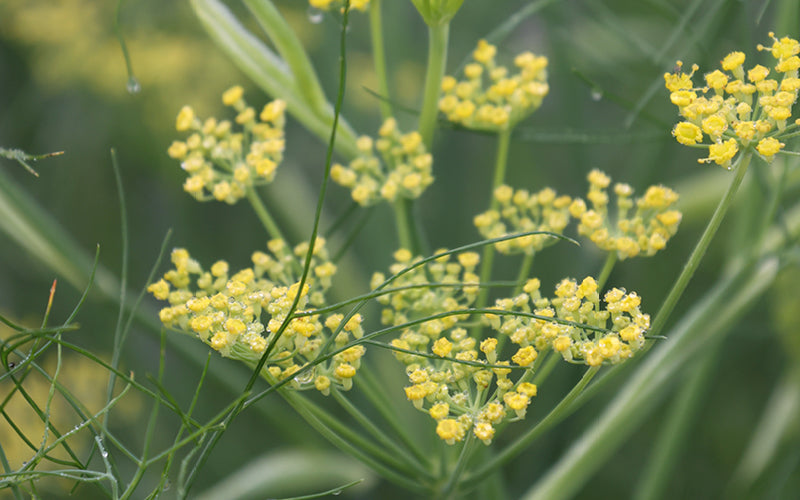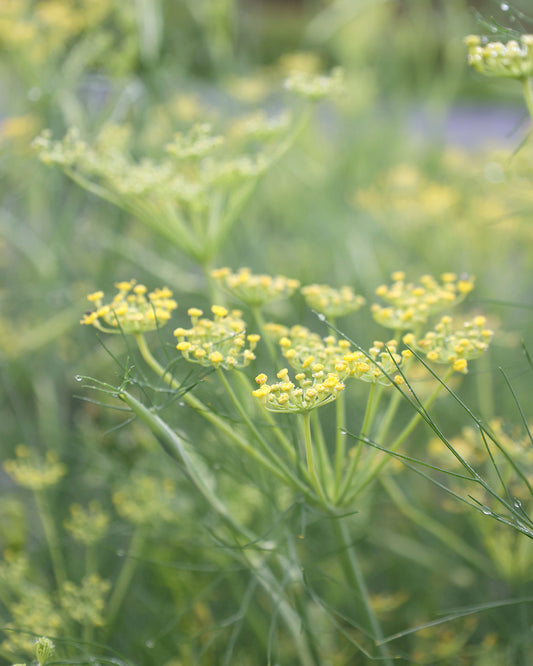Planting, caring for & harvesting fennel (Foeniculum vulgare) – tips for cultivation and use in the garden
Fennel is trending – thanks in particular to Mediterranean cuisine, this aromatic bulbous vegetable has become increasingly popular in German gardens. The cultivated form of sweet fennel not only scores points with its mildly spicy, slightly aniseed flavor, but also with its versatile uses in the kitchen. The crisp, white-green bulb is primarily consumed, but the finely feathered leaves are also excellent for seasoning salads, dips, or fish dishes. In this article, you'll learn everything you need to know about growing fennel – from proper sowing and care to harvesting and processing.

Planting time – When is the right time?
Sowing of fennel begins in April, as soon as the soil has warmed sufficiently. In Central European regions, the ideal period is April to May. Later sowings can be problematic, as heat or drought can cause the fennel to bolt quickly. For successful bulb development, fennel should grow as early as possible and with consistent soil moisture.
Fennel cultivation – How it works in the garden
Sow directly into the bed—in shallow furrows about 25 centimeters apart. Leave about 40 centimeters between rows. The seeds are covered with compost and then lightly pressed down with the back of a rake. Water thoroughly after sowing.
Once the young plants are about 10 centimeters tall, thin them out to a distance of about 20 centimeters. Only strong plants should be left standing – this ensures healthy development and sufficient space for tuber formation.

Fennel 'Spice Fennel' – Foeniculum vulgare
'Spiced Fennel' is a Mediterranean annual or biennial medicinal and spice plant with a light anise flavor. Unlike bulb fennel, 'Spiced Fennel' does not form a bulb, so only the young shoots and seeds are used. Starting in July, its yellow flowers appear, attracting numerous insects. It is not only versatile in the kitchen, but its delicate blossoms also create attractive contrasts in flowerbeds.
Our high-quality organic herb seeds are grown according to the strictest organic standards for a sustainable and healthy harvest.
Details:
Sowing indoors/greenhouse: March to April
Planting outdoors: mid-March to May
Germination time: 7-14 days at 15-20°C
Sowing depth: 0.5 cm
Height: approx. 120 - 200 cm
Planting distance: 30 x 25 cm
Harvest time: August to September
Soil: loose, humus-rich, permeable
Fertilization: Organic fertilizer
Location: Sun
Water consumption: high, regular
Growing tips:
'Fennel' develops quite slowly, so it may be advisable to start it early in March. Overall, it requires relatively little care, but it must not be allowed to dry out. Ensure consistent watering.
The fresh leaves can be harvested and processed at any time. The flowers are ready to be harvested when they begin to open.
The seeds don't fully ripen until the second year and should be harvested in October and November, as they will otherwise fall off with the first frost. The dried seeds are best stored in a clean screw-top jar.
In winter, the above-ground shoots die back. In spring, any remaining, dried-out shoots should be removed to allow vigorous new growth. Applying organic fertilizer in early summer promotes healthy growth.
Mixed culture:
Good neighbors: chicory, peas, cucumbers, lettuce, ointment
Bad neighbors: Dill, beans, caraway, tomatoes
Use:
Fennel leaves can be chopped and used in quark, meat, vegetable, and fish dishes. The seeds are ideal for seasoning soups, meat, fish, pastries, or bread.
The tea made from the seeds has a sweet, anise-like taste and is said to help with coughs and stomach aches and relieve cramps and inflammation.
.
Bag contents:
Contents: approx. 500 grains
Store in a cool, dry place.
Location – Where does fennel grow best?
Fennel loves sunny, warm locations and requires nutrient-rich, humus-rich, and evenly moist soil. Waterlogging should be avoided, as should prolonged dry periods, as these can inhibit growth and lead to premature bolting. A sheltered, windless location is also beneficial.
Care – What should you keep in mind when growing fennel?
Consistent watering is crucial throughout the entire growth period. To encourage tuber formation, lightly mound the plants as soon as the first thickenings appear at the root base. This process can be repeated once or twice to keep the tubers tender, light, and partially bleached.
Fertilize sparingly: a little mature compost or organic fertilizer is sufficient. Excessive nitrogen applications should be avoided, as they can promote the accumulation of harmful nitrates. Consistent soil moisture also helps promote shoot growth.
Harvest – When is fennel ripe?
The bulbs are ready for harvest approximately 100 days after sowing. The bulbs should be firm, white, and about the size of a fist. Harvesting is best done with a sharp knife or spade. Fennel can be stored in the refrigerator for about a week immediately after harvesting. Late-harvested fennel can also be stored in a cool cellar or in moist sand, which will keep it fresh for significantly longer.
Mixed culture – Which plants go well with fennel?
Fennel combines well with peas, basil, leeks, endive, lamb's lettuce, parsnips, cucumbers, sage, sunflowers, or celery. It should be avoided growing it next to other umbelliferous plants or vigorous plants like tomatoes or potatoes, as this can cause competition for water and nutrients.
Botany – What kind of plant is fennel?
Fennel belongs to the Apiaceae family. It forms a striking, bulbous growth at the base of the stem, composed of fleshy leaf sheaths. The upright, blue-green stem can grow up to two meters tall. The finely feathered, almost dill-like leaves give fennel its distinctive appearance.
In its second year, fennel forms double-umbeled inflorescences with numerous small, yellow flowers. Fennel contains essential oils, abundant minerals, and vitamins, and is not only valued as a vegetable, but also used in teas, to flavor dishes, and as a medicinal plant—for example, for coughs or digestive problems.
Cultural history – How did fennel come to us?
Fennel was already known and valued in the Mediterranean and the Middle East in ancient times – both as a medicinal plant and as a spice. The Romans brought it to Central Europe, but it was the monasteries that made it an integral part of the Central European flora through systematic cultivation.
The bulb fennel we know today was bred by Italian gardeners in the 19th century and is a staple in their cuisine. Fennel only became more widely known in Germany in the 1960s, but it still plays a relatively minor role in home cultivation. However, it can be regularly found in well-stocked greengrocers or at farmers' markets – as well as in an increasing number of Mediterranean-influenced vegetable gardens.









































































































